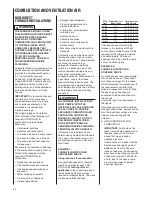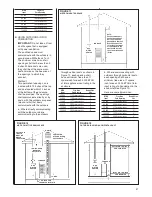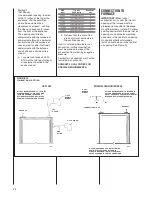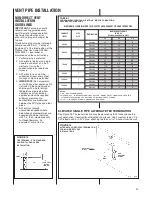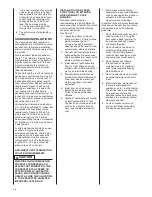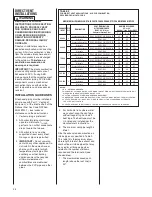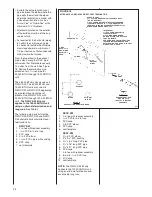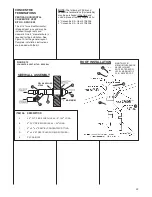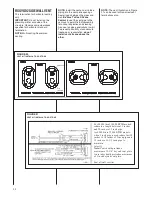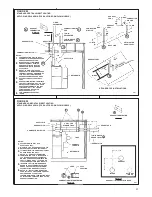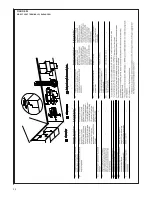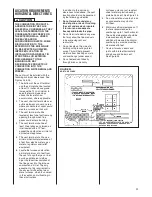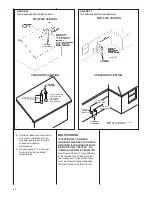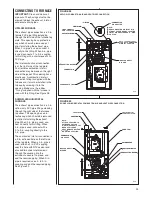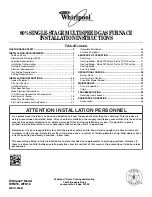
33
LOCATION REQUIREMENTS
HORIZONTAL DIRECT VENTS
THE COMBUSTION PRODUCTS
AND MOISTURE IN THE FLUE
GASES WILL CONDENSE AS THEY
LEAVE THE TERMINATION. THE
CONDENSATE CAN FREEZE ON
THE EXTERIOR WALL, UNDER
THE EAVES AND ON
SURROUNDING OBJECTS. SOME
DISCOLORATION TO THE
EXTERIOR OF THE BUILDING IS
TO BE EXPECTED. HOWEVER,
IMPROPER LOCATION OR
INSTALLATION CAN RESULT IN
STRUCTURAL OR EXTERIOR
FINISH DAMAGE TO THE
BUILDING AND MAY
RECIRCULATE PRODUCTS OF
COMBUSTION INTO THE
COMBUSTION AIR TERMINAL AND
FREEZE.
The vent must be installed with the
following minimum clearances. See
Figures 24 & 25.
1. The bottom of the vent terminal
and the air inlet shall be located
at least 12 inches above grade.
Increase the 12-in. minimum to
keep the terminal openings
above the level of snow
accumulation, where applicable.
2. The vent shall not terminate over
public walkways or over an area
where condensate or vapor could
create a nuisance or hazard.
3. The vent terminal shall be
located at least one foot from any
opening through which flue
gases could enter a building.
4. The vent terminal shall be at
least 3 feet above any forced air
inlet located within 10 feet,
except the combustion air inlet of
a direct vent appliance.
5. The vent terminal shall have a
minimum horizontal clearance of
4 feet from electric meters, gas
meters, regulators and relief
equipment.
6. Locate the furnace combustion
air inlet minimum of 3 feet from
the vent of any other gas or fuel
burning appliance or clothes
dryer to prevent recirculation of
the flue gases into the furnace
combustion air inlet. The only
exception to this requirement is
the case of multiventing two or
more furnaces, which is covered
in the section on multiventing in
these instructions.
In addition to the minimum
clearances listed above, the vent
location should also be governed
by the following guidelines.
1.
Do not terminate under any
kind of patio or deck. If running
the vent under a deck, insulate
it to insure no condensate
freezes and blocks the pipe.
2. Do not terminate behind any area
that may allow the flue products
to become stagnant and
recirculate.
3. Do not locate on the side of a
building with prevailing winter
winds. This will help prevent
moisture from freezing on walls
and overhangs (under eaves).
4. Do not extend vent directly
through brick or masonry
surfaces, unless a rust-resistant
sheet metal or plastic backing
plate behind vent. See Figure 25.
5. Do not locate too close to shrubs
as condensate may stunt or
kill them.
6. Minimum vertical clearances of 1
foot are recommended for
overhangs up to 1 foot horizontal.
The vertical clearance should be
increased equally for each
additional increase in horizontal
overhang to a maximum vertical
clearance of 6 feet.
7. Caulk all cracks, seams and
joints within 6 feet horizontally
and above and below vent.
See Figure 25.
FIGURE 25
MOISTURE ZONES
!
CAUTION
2 FT. SQ. SHEET METAL PLATE ON BRICK OR
MASONRY SURFACE RECOMMENDED, BUT
NOT REQUIRED BY CODE.
Summary of Contents for GF901D Series
Page 60: ...60 FIGURE 52 MODELS WITH UT ELECTRONIC CONTROLS 1097 200 ...
Page 61: ...61 FIGURE 53 MODELS WITH UT ELECTRONIC CONTROLS 1097 200 ...
Page 62: ...62 ...
Page 63: ...63 ...
Page 64: ...64 CM 0611 ...


